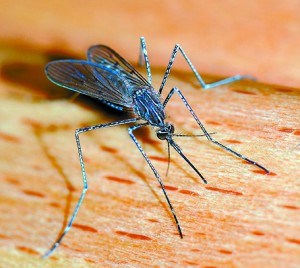 ÔÇťThere are about 30 species of mosquito in Alberta,ÔÇŁ says Jenkins, ÔÇťbut I suspect you have a lower diversity of species in Jasper.ÔÇŁ In general, the fluctuating temperatures, and more severe terrain of the mountains limit the species that can survive here. Still, Jasper shares many species with Edmonton, and patterns of behaviour can be similar.
ÔÇťThere are about 30 species of mosquito in Alberta,ÔÇŁ says Jenkins, ÔÇťbut I suspect you have a lower diversity of species in Jasper.ÔÇŁ In general, the fluctuating temperatures, and more severe terrain of the mountains limit the species that can survive here. Still, Jasper shares many species with Edmonton, and patterns of behaviour can be similar.
Jenkins explains that all mosquitos overwinter on their breeding grounds in one life stage or another. The ÔÇťbig slow guysÔÇŁ that first emerge in the spring are often adult females that mate in the fall, then spend the winter in animal burrows and dens that remain above freezing. ┬áIn the early spring, the females emerge from the dens, find some blood to feed on, and lay eggs that produce the next generation of adults. They move slowly because of cooler weather. Mosquitoes are ectotherms, and like other insects depend on external temperatures for body heat.
The majority of species in Alberta, however, spend the winter as drought resistant eggs. ÔÇťMost Alberta species lay eggs on vegetation beside bodies of water. The eggs harden until they are covered by water and activate at a later date.ÔÇŁ Jenkins says some mosquito eggs can be dormant for up to 10 years. The eggs are amazingly resilient, even extremely frigid temperatures will have little affect on their survival.
Given the need for water to activate the eggs, Jenkins says weather is the biggest predictor of mosquito populations. ÔÇťFor most species, the more rain we get, the more mosquitoes we get.ÔÇŁ In the mountains, itÔÇÖs not just rain, but the amount of flooding related to quantity and timing of snow-melt. So far, the combination of these factors have made for significantly less extreme conditions than in the spring of 2012.
However, wet years can allow drought-resistant species to build up their populations. ÔÇťOnce a large population develops, they leave behind a large contingent of waiting and dormant eggs, ready to hatch during the next set of ideal environmental conditions. Events can sometimes snowball,ÔÇŁ says Jenkins. He points to a stretch of wet years in the 1980s, when Edmonton experienced massive mosquito populations, as one year built upon the next.
The good news is that not all species hatch out the moment they are wetted in the spring. Jenkins says some eggs need to be covered by water anywhere from two to 17 times before they hatch. Repeated flooding and multiple rain events can contribute to this wet-dry cycle. Jenkins suggests the requirement for some eggs to be covered by water repeatedly is an adaptation to avoid the cooler weather and water of spring. This also means that a drier spring and summer could prevent some speciesÔÇÖ eggs from hatching at all.
There are a couple of species in the province that, instead of laying drought resistant eggs near the edge of water bodies, lay ÔÇťegg raftsÔÇŁ on water surfaces. Jenkins says any surface will do: puddles, birdbaths and old tires in addition to naturally occurring water bodies. These pencil eraser-sized rafts float like little pieces of cork on the waterÔÇÖs surface, and contain hundreds of larva. Although rain leads to more opportunities for these species to lay eggs, they are less inhibited by the weather as they are not stationary, and donÔÇÖt require flooding to activate. In other words, as long as thereÔÇÖs standing water somewhere, they can breed. Jenkins says ÔÇťwe are luckyÔÇŁ to have only two of these more opportunistic species in the province.
Based on weather trends for our area, and the amount of eggs likely out there, itÔÇÖs probably reasonable to assume that weÔÇÖre going to see a fair number of mosquitoes flying around the park this summer.
We can try and console ourselves by thinking about all the dragonflies that will get fat on their little bloodsucking bodies, and the birds that will beef-up for long seasonal migrations. In the meantime, get a good mesh tent, haul out your mosquito jackets, and get ready to start slapping.
